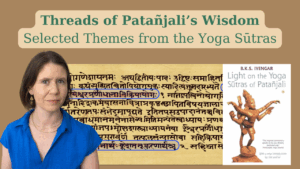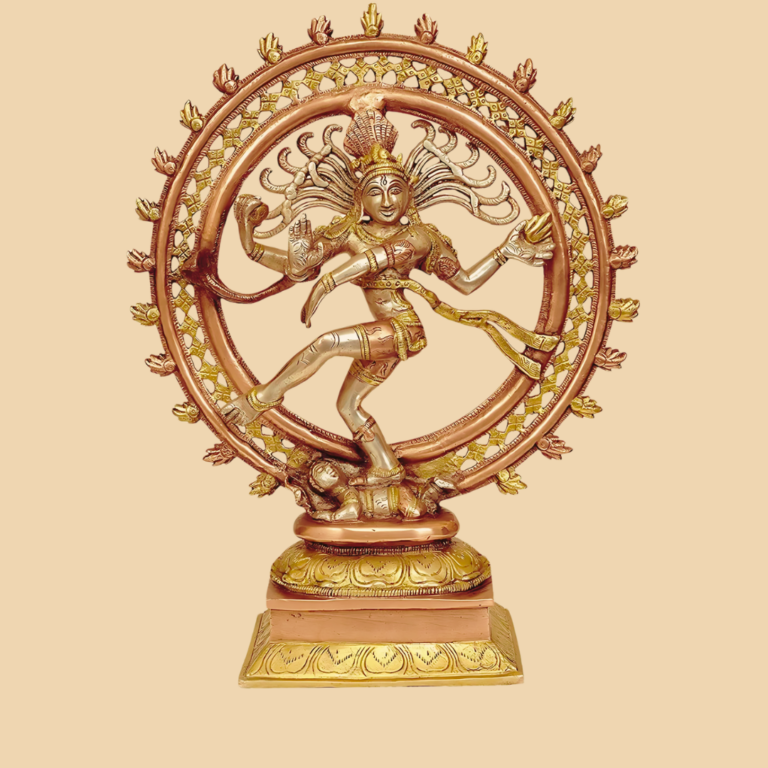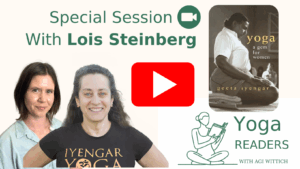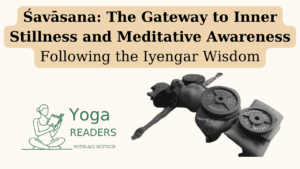
Threads of Patanjali’s Wisdom – Online Course
A course of selected themes from the Yoga Sutras with Dr. Agi Wittich The Yoga Sūtras of Patañjali are the philosophical heart of yoga.

In “The Tree of Yoga”, BKS Iyengar shares a fascinating story that bridges these two arts through a divine performance. The story begins with Lord Siva inviting Lord Vishnu to witness his tandavanrtya – the cosmic dance of destruction and creation. As Vishnu watched while seated on Adisesa (the lord cobra), something remarkable happened: his body became so heavy that Adisesa struggled to breathe, only returning to lightness when the dance ended.
“Lord Siva invit[ed] Lord Vishnu to witness his tandavanrtya – the cosmic dance of destruction and creation.” What follows is a remarkable description of Viṣṇu’s response to this divine performance – his body became “so heavy that Adisesa struggled to breathe.” This physical response serves as a powerful metaphor for the transformative nature of artistic and spiritual experience, bridging the gap between physical sensation and divine consciousness. The heaviness experienced by Ādiśeṣa can be understood as a manifestation of divine consciousness, a representation of the transformative power of artistic experience, and a symbolic bridge between physical and spiritual realms.
What I find particularly touching is Adisesa’s reaction. When he asked Vishnu about this phenomenon, Vishnu explained that he had become completely absorbed in Siva’s dance, causing his body to vibrate and become heavy. This reminds me of those rare moments in practice when we become so immersed that we lose awareness of our physical weight.
Here’s where the story takes an unexpected turn that connects to our yoga lineage: Adisesa, inspired by his master’s appreciation of dance, asked to learn it himself. Vishnu’s response links this mythological tale directly to yoga philosophy: he told Adisesa that he would learn dance when the time came to write the Mahabhdsya (the great commentary on grammar). Iyengar reveals that this Adisesa would later incarnate as none other than Patanjali, the author of the Yoga Sutras!
What fascinates me most is how Iyengar uses this story to explore the relationship between yoga and art. He explains that while yoga follows nivrtti-marga (the inward path of renunciation), dance follows pravrtti-marga (the outward path of creation). “The difference between yoga and dance is that yoga is the perfect art in action, whereas dance is a perfect art in motion.” Have you noticed how your yoga practice contains both stillness and dynamic energy? As Iyengar points out, while yoga might appear static to an observer, there is “intense inner dynamism” within each pose.
The text then takes an interesting turn into emotional territory. We all experience lust, anger, greed, infatuation, pride, and jealousy. But here’s the difference: while dancers transform these emotions into artistic expression, yogis work to master them through cultivating friendliness, compassion, joy, and equanimity – as prescribed in Patanjali’s Yoga Sutras (1.33).
Central to Iyengar’s understanding is the distinction between dance and yoga as complementary paths to spiritual realization. His observation that “yoga is the perfect art in action, whereas dance is a perfect art in motion” establishes a sophisticated framework for understanding the relationship between movement and stillness. This distinction becomes particularly significant when examining the nature of these practices: while dance represents the external expression of internal states, yoga manifests as internal dynamism within apparent stillness.
The spiritual pathways of these practices are equally distinct yet complementary. Yoga follows the nivṛtti-mārga, the inward path of renunciation, while dance embodies the pravṛtti-mārga, the outward path of creation. This dichotomy provides a theoretical foundation for understanding different approaches to spiritual practice within Indian traditions.
Iyengar’s classification of artistic expression provides a hierarchical understanding that remains relevant to contemporary practice. He identifies yoga-kalā as divine art born from inner depth, bhoga-kalā as art for pleasure, and kama-kalā as art for sensual gratification. This classification offers profound insights into the varying levels of artistic and spiritual engagement possible in both dance and yoga practices.
The narrative reaches its culmination in the revelation that Ādiśeṣa would later incarnate as Patañjali, author of both the Mahābhāṣya and the Yoga Sūtras. Iyengar recounts that Viṣṇu told Ādiśeṣa “that he would learn dance when the time came to write the Mahābhdsya (the great commentary on grammar).” This connection between grammar, yoga philosophy, and artistic expression represents a unique synthesis in Indian intellectual history. The interweaving of these traditions suggests a deeper understanding of the relationship between language, movement, and consciousness that warrants further scholarly investigation.
In addressing emotional transformation, Iyengar draws a crucial distinction between the approaches of dancers and yogis. Dancers transform emotions through artistic expression, creating external manifestations of internal states that align with traditional aesthetic theories of rasa. In contrast, yogis work with emotions through the cultivation of opposing qualities, as prescribed in Patañjali’s Yoga Sūtra 1.33: developing friendliness (maitrī), compassion (karuṇā), joy (muditā), and equanimity (upekṣā).
Iyengar’s assertion that “without shape and form, without grace and without strength, one can neither be a yogi nor a dancer” underscores the fundamental importance of physical cultivation in both practices. This understanding of the body as a sacred vessel has evolved through historical developments in both yoga and dance techniques, leading to contemporary applications in body-mind practices, somatic education, and therapeutic interventions.
What strikes me as particularly relevant for modern practitioners is Iyengar’s discussion of art and yoga’s shared need for bodily respect. He argues that “without shape and form, without grace and without strength, one can neither be a yogi nor a dancer.”
Modern scholarship necessitates a critical examination of these traditional narratives while maintaining respect for their cultural significance. The identification of Patañjali as Ādiśeṣa’s incarnation must be examined through historical documentation, textual variations, and the sociological functions such narratives served in their original contexts. This analysis reveals complex patterns of knowledge transmission and cultural authentication processes that continue to influence modern yoga practice.
Iyengar’s observation about the “intense inner dynamism” within apparently static yoga poses deserves particular attention. This concept challenges the simple dichotomy between movement and stillness, suggesting instead a spectrum of embodied experience. When he states that “yoga is the perfect art in action, whereas dance is a perfect art in motion,” Iyengar points to a sophisticated understanding of how internal and external movement relate to spiritual development.
The text’s treatment of emotional experience offers valuable insights for contemporary practice. While acknowledging universal human experiences of “lust, anger, greed, infatuation, pride, and jealousy,” Iyengar presents distinct approaches to working with these emotions. The dancer’s transformation of emotion into artistic expression and the yogi’s cultivation of opposing qualities represent complementary approaches to emotional refinement and spiritual growth.
Modern practitioners can find particular relevance in Iyengar’s discussion of bodily respect and cultivation. His insistence on the importance of “shape and form” and “grace and strength” speaks to contemporary concerns about physical wellness and embodied spirituality. These principles find application in modern movement therapy, emotional processing techniques, and trauma-informed practices.
The synthesis of dance and yoga principles suggests innovative approaches to teaching both disciplines. Understanding the relationship between external movement and internal transformation can inform how we structure practice sequences, guide students through emotional processes, and facilitate deeper spiritual understanding. This integration of traditional wisdom with contemporary pedagogical methods offers rich possibilities for modern teaching approaches.
The intersection of dance and yoga traditions, as illuminated through Iyengar’s interpretation of the Śiva’s Tāṇḍava narrative, suggests numerous avenues for future research. Empirical studies might examine the neurological effects of different movement practices, while historical research could further illuminate the development of these interrelated traditions. Practical applications might include the development of integrated practice methods and therapeutic protocols that draw on both yogic and dance traditions.
The relationship between Śiva’s Tāṇḍava and yoga practice, as interpreted by Iyengar, offers profound insights into the nature of movement, spirituality, and transformation. Through careful analysis of this tradition, we can better understand how physical practice, emotional refinement, and spiritual development interweave in both dance and yoga. This understanding has significant implications for contemporary practice, teaching, and research, while honoring the depth and sophistication of traditional wisdom.
As modern practitioners and scholars continue to explore these relationships, Iyengar’s interpretation serves as a valuable bridge between ancient wisdom and contemporary understanding. His insights into the complementary nature of dance and yoga, the importance of physical cultivation, and the transformation of emotion continue to offer guidance for practitioners and researchers alike.

A course of selected themes from the Yoga Sutras with Dr. Agi Wittich The Yoga Sūtras of Patañjali are the philosophical heart of yoga.

In a recent Yoga Readers session, Dr. Lois Steinberg opened her teaching archives and personal memories, sharing stories that span four decades of study

In the vast and intricate repertoire of yoga āsanas (postures), Śavāsana (Corpse Pose) holds a unique and profoundly significant position. Often superficially perceived as
Agi Wittich is a yoga practitioner since two decades, and is a certified Iyengar Yoga teacher. Wittich studied Sanskrit and Tamil at the Hebrew University of Jerusalem, Israel, completing a PhD with a focus on Hinduism, Yoga, and Gender. She has published academic papers exploring topics such as Iyengar yoga and women, the effects of Western media on the image of yoga, and an analysis of the Thirumanthiram yoga text.